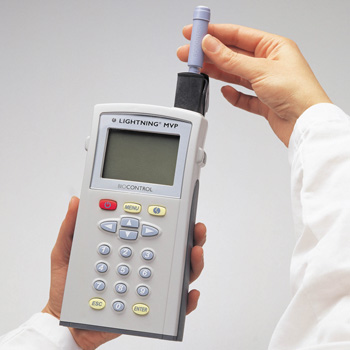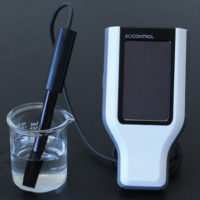Everyone has heard the truism, “What gets tracked, gets done.” It applies not only to human nature but bears relevance on any systematic process, such as Good Manufacturing Practices (GMPs) and Hazard Analysis and Critical Control Points (HACCP). Behind every successful HACCP program are effective tracking and monitoring systems that ensure quality control criteria are consistently met.
Bellevue, WA-based BioControl Inc., a worldwide leader in food safety testing, offers a solution with the LIGHTNING MVP—a single instrument that measures, records and analyzes results from multiple HACCP controls. These measurements include ATP bioluminescence as a tool for sanitation validation, temperature and pH for the verification of critical control points (CCPs) and conductivity as a measurement of sanitizer concentration.
The new LIGHTNING MVP Conductivity Probe is the next evolutionary step for the LIGHTNING MVP, adding its fourth and fifth testing parameters. “Many processors will find value in conductivity testing, and even more the ability to quantitatively measure sanitizer and cleanser strength, a significant budget line item,” notes Anita Kressner, Director of Product Marketing at BioControl. “By receiving a definitive numeric value for the solution concentration rather than a broad range typical of most test strips, a quality assurance manager can be assured their budget dollars are not going down the drain. Even in a medium-sized plant, a 5% overuse in sanitizers can amount to tens of thousands of dollars per year of unnecessary expense.”
Existing methods of concentration testing, such as strips and titration kits, are very subjective, requiring employees to judge results with as much variance as 100-150 parts per million (ppm). “When the difference between being too weak to effectively sanitize, and too strong and risking food adulteration is as little as 50 ppm, a variance of 150 ppm is simply too high to be acceptable,” asserts Kressner. The LIGHTNING MVP can accurately read a chemical’s concentration to within approximately 10 ppm.
Monitor HACCP, Not Just Hygiene
One of the primary benefits of a system that monitors multiple HACCP components is that results from all measurements can be transferred to a computer for trending, analysis and record keeping—all in one central database. “HACCP is a system, one in which each component is interconnected to the others, so it made sense to develop a monitoring and tracking device based on that same concept,” says Kressner.
With the LIGHTNING MVP, she adds, results are automatically logged along with the time and date providing a strong audit trail. This is a clear improvement over recording measurements on a clipboard and periodically transferring them to a spreadsheet, which is a common tracking method. “Even if a plant has an automatic sanitizer and cleanser dispensing system, monitoring is valuable, providing an audit of the system settings,” maintains Kressner.
Using a single unit to monitor HACCP saves money on instrument costs and simplifies training and maintenance. But more importantly, when one database is maintained, the audit trail for critical control points and SSOPs is simplified and results can be analyzed as a whole, providing new insights into food safety and quality.
BioControl approached the development of each measurement parameter with the same system-based thinking as they did with the development of the LIGHTNING MVP system. A good example of this is how ATP is measured with the instrument.
“When we set about to develop the LIGHTNING MVP, we carefully looked at each component of ATP testing: the instrument, swab, software and calibration capabilities.” When a plant thinks about any measurement system that does not include one or more of these components, she stresses, they should recognize the effect it will have on the integrity of the total system, and the resulting impact on food safety and quality.
For the system to provide valid results the instrument and swab must work together. The LIGHTNING MVP instrument software is optimized to the specific chemistry contained in the swab so that readings are accurate and consistent. Calibration rods must provide standards for high and low levels of light output from which the instrument can reset its sensors. Positive and negative controls are needed to validate swab lots. “All of these elements must work together as a whole to provide reliable, reproducible results,” states Kressner. “This is true for ATP monitoring, just as it’s true for HACCP monitoring and HACCP programs as a whole.”
Behind every successful HACCP program are effective tracking and monitoring systems that ensure that quality control criteria are consistently being met. By monitoring those criteria using a systems-based monitoring tool, costs are lowered and food safety is improved.
biocontrolsys.com
Uncover Hidden Costs with System Based HACCP Monitoring



